TYPES OF BEER
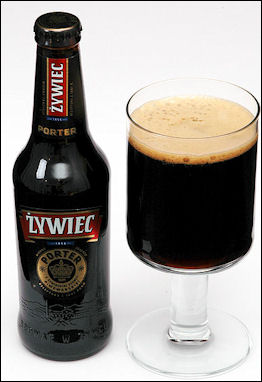
Porter The color of beer usually depends on how long its component grains are roasted. Dark beers tend to have dark-roasted barley as their base. They have sweet, toasty flavors. Roasting decreases the amount of sugar in the grain available to be fermented, so despite their strong-looking color, dark beers are not necessarily higher in alcohol than light ones.
Lager is the world's most popular type of beer. A light carbonated brew popular in America, it has a light crisp taste and is brewed through slow fermentation and matured at cold temperatures. Golden pilsner lager originated in the Czech Republic. “Lager” means "cellar." The clear color is the result to slow-acting yeasts working at a low temperature. Most pubs in Britain serve lager and bitter (a flat beer)
Ales ferment at a much higher temperature than lagers, resulting in an alcohol content of 12 to 14 percent, a stronger aroma, a heavier body, a creamier texture and a flavor that is stronger and more complex. Some ales are fermented three times. By contrast, most American beers go through a single fermentation and are carbonated and bottled and have an alcohol content of six percent. Ales are meant to be sipped rather than chugged and best served around 50̊F.
Websites and Resources: Michael Jackson’s Beer Hunter /michaeljacksonthebeerhunter.blogspot.com ; Michael Jackson’s Beer Style Index beerhunter.com/beerstyles.html ; Realbeer.com realbeer.com ; Wikipedia article Wikipedia ; Beer Advocate /beeradvocate.com ; Types of Beer thenibble.com/reviews/main/beer/glossary ; Beer Type Chart drinkingbeer.net/BeerArticles/Beer_Types ; Beer Style Guidelines brewersassociation.org ; Wikipedia article on History of Beer Wikipedia ; History of Beer Comics manolith.com ; Foaming Head Beer History thefoaminghead.com/history ; Beer Production Charts hyfoma.com ; Beer Production in Pictures inwithbacchus.com/2010/10/in-with-bacchus-guide- ; Book: “Beer Essentials” by F. Paul Pacult (1997)
Guinness Stout
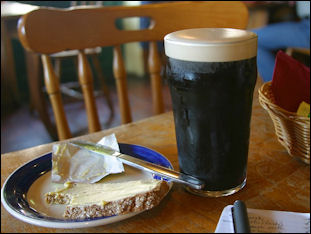
stout Porter is a kind of dark beer, first described in London in the 19th century, usually made drom dark malts. "Coal-black" and "creamy headed" stout originated around the same time as an extra strong porter. The most popular kind of stout today is Guinness Stout, is dark gritty associated with Ireland.
It has been said that Guinness is synonymous with Ireland and Irish heritage. In some places a bottle of Guinness Stout has traditionally been the only thing an Irish worker had for lunch. Irish sociologist Christopher Curtain told the New York Times, "To be a drinker was to be drinking Guinness. And if you were to ask what drink would you have above any other, it would be Gluiness."
An adverting campaign for Guinness once featured the slogan "Guinness is Good for You." Over the years it has been said to have restorative vitamins, bring benefits to pregnant women and make young men virile and powerful.
Guinness is supposed to consumed at room temperature. To a pour a glass of stout properly the bartender first fills the glass three quarters full and lets it stand. In an Irish pub often there will be rows of unfilled glasses lined up behind the tap. When the foam settles the glass is filled to the top and the excess foam is removed with a knife as if the stout is getting a shave.
Sometimes bubbles in a glass of Guinness stout defy the laws of nature and travel downward. In January 2000, scientists at the University of New South Wales in Sydney announced an explanation for this phenomena: Bubbles form at the bottom of the glass and start to rise taking liquid with them. Bubbles in the center move faster than those on the outside, near the glass. The liquid has go somewhere so it goes downward. Because Guinness is so viscous it takes bubbles down with it.
Guinness Stout Brewery

old Heineken brewery In 1759 Arthur Guinness purchased Rainsford Brewery in Dublin, renamed it the St. James Gate brewery, and began brewing ales and porters there. Guinness Stout was invented in the 1820s when the brewery began producing a porter called "extra stout." As the company grew it built housing for the poor and developed St. Stephen's Green as a gift to Dublin. The company’s symbol, the harp, is also the symbol of Ireland.
The Guinness Brewery is the largest in the world. It covers a 59 acre site next to the River Liffey and produces over 10 million bottle of stout a day. Owners of the brewery insist it is not the polluted waters of Liffey that gives Guinness its distinctive taste. Over three million gallons of spring water a day is pumped in from a spring 25 miles away in County Kildare. Guinness is now owned by Diageo, the international food conglomerate that also owns Pillsbury, Burger King, Smirnoff and Johnnie Walker.
In Ireland, Guinness Stout is not as popular as it once was. While it remains the most popular drink in Ireland, it sales declined in recent years. The Irish are more worldly, more willing to experiment and more in the mood for drinking other things like ales, ciders, wine and ready-to-drink concoction with vodka and rum and other drinks. Between 1995 and 2000, the sale of lagers has surpassed the sales of stout for the first time ever in Ireland. Despite this trend the sales of Guinness Stout is booming internationally. It is popular in the United States and Japan.
German Beer
Germans consume more beer per capita than other people. Each year as a nation they down 11 billion liters of beer and the average German consumes 38 gallons (144 liters) of beer a year, compared to 22.8 gallon a year in the U.S. and 27.1 in Britain. Even Martin Luther, the founder of Protestant religion, was a big beer drinker.
Germany has hundreds of breweries. Each town often has a brewery and the taste of each brew can very quite a bit from place to place. All German beers are brewed according to the “Reinheitsgebot”, the German Purity Law which has been in force since 1556 and stipulates that only four ingredients can used in making beer: barley-malt, hops, yeast and water. No preservatives or foam stabilizers are used. Traditionally, "impure" foreign beers have been kept out of the country.
Germany produces 3.1 billion gallon of beer a year, ranking the country second in the world in beer production behind the United States which makes 6.2 billion gallons of beer a year. The top 5 beer making counties (tons per year): 1) USA (23,655,000); 2) Germany (11.806,000); 3) China (6,926,000); 4) Japan (6,232,000); 5) the UK (6,006,000).
Beer consumption (1997): 1) Germans (170 liters a year); 2) Czechs (148 liters a year); 3) Americans (105 liters a year) Four largest beer markets: 1) U.S., 2) China, 3) Germany and 4) Japan.
The Kummerrower Hof and hotel in Nuerzell offers beer baths in which guests relax in five liters of beers delivered directly into the bath tub from a tap. The beer baths are credited with reducing high blood pressure, relieving skin problems and helping people sleep better. The key ingredient, reputedly, is the natural carbonic acid found in beer.

Beer types diagram
German Beer Brands
Germany has hundred of different kinds and brands of beer. Kinds of world famous German beer include “pilsner” or “pils” (light beer), “Weizen” (wheat), “Alt” (old). Among the brand with a good reputation are Flensburger in the north, Veltins in the west, Rothaus in the southwest and Czech-made Budweiser. Wheat beer is popular in Berlin. East Berliners favor cheap draft beer whole West Berliners like Berliner Weisse, a sweet beer served with a dash of raspberry syrup.
Beck's is Germany's No. 1 exported beer, Founded in 1553, the Beck Brewery is one of the oldest beer breweries in the world and is a private family-owned business. Beck's attributes the success of their beer to the water which comes from their own 1,000-feet-deep artisan wells.
According to the Guinness Book of Records, the world’s oldest brewer in the Weihenstephan Brewery in Fresing near Munich. It was founded in A.D. 1040. Germany also has a connection with Budweiser. In 1865, Alpolphus Busch, 25, a recent immigrant to the United States from Germany, married the daughter of Eberhard Anheiser in St. Louis and was made a partner in his father-in-law's brewery.
German Beer Halls and Oktoberfest
Oktoberfest is the world's most famous beer festival. Held in Munich since 1831, it lasts for 16 days and features beer-drinking tents, oompah bands, and lost of drunk tourists and Germans. On average about 7 million people attend the festival and down about 5.2 million liters of beer. Eighty or so oxen are cooked for the crowds as well as thousands of chicken wings and sausages.
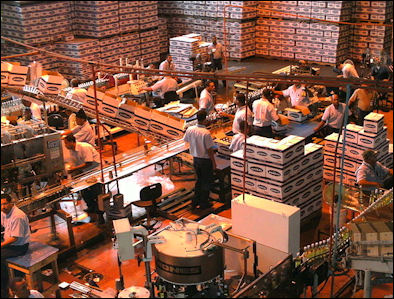
Oktoberfest ends on the first Sunday in October. It grew out of a Bavarian wedding celebration in 1810 for King Maxmillian I and a Saxon princess and evolved into a harvest festival. It is the world's biggest beer party. The Costume and Marksmen Parade is a German version of Mardi Gras with Clydsedales, polka bands and brewmasters.
The waitresses at Oktoberfest are amazing. Some can hoist a dozen huge liter mugs of beer at one time, while their bottoms and cheeks are being pinched by the customers. Foreigners make up about 15 percent of the participants. Most of them are from Austria, Italy and France. During one Oktoberfest two rollercoaster cars collided with one another and 26 people were injured. On average the Red Cross it treats about 2,300 drunk or injured revelers.
Germany is famous for its huge beer halls, which are generally only found in Munich and Bavaria. In 1995, local authorities in Munich attempted to close down a popular beer hall at 9:30pm because the noise level bothered local residents. Over 20,000 people demonstrated and 200,000 signed a petition, protesting the decision. The Bavarian cabinet stepped in and overruled the municipal government, allowing the beer gardens to stay open until 11:00pm (with a last call at 10:30 pm and no music after 10:00pm).
British Beers
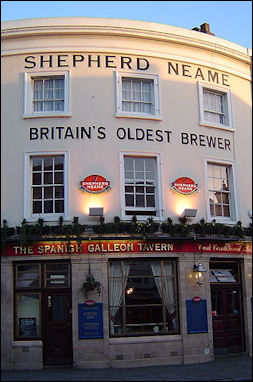
In Britain, beer, is most commonly served warm and comes in two basic types: bitter (a flat beer) and lager (a carbonated brew of style popular in America). Stout (like Guinness), real ale and a variety of other beer-related drinks are also available. At a pub people usually order beer by the pint or half pint and specify that want, for example a "half pint of stout" or a "pint of bitter."
In Britain there are around 600 different breweries and they produce 2,700 different beers. The world's strongest beer (23 percent alcohol) is Baz's Super brew sold at the Parish Brewery in Somerby, England. English barley wine and Scottish strong ale have an alcohol content for 12 to 14 percent. Traditional brewed beers include Clog Dancer, Old Speckled Hen and Whistle Bely Vengence. Among the unusual brews are McEwans Scotch Ale, Young Old Nick, Young's Oatmeal Stout.
Many estates had their own microbeweries, often in a separate building, with boilers, lead-lined vats, wooden tubs for infusing barley malt, fermenting the mixture and filtering it.
England, Ireland and Scotland still make amber-to-near-black porters and stouts and golden ales. Stout and ale are made with barley and hops. Strong beer-like drinks include found in Britain include "winter warmer," "scrumpy" and "real ale." Real ale served direct from the cask.
Book: The Good Beer Guide by CAMRA (campaign for Real Ale) list 5,000 pubs.
Belgian Beer
Belgium beer is regarded by some as the best in the world. At some restaurants beer is served with the same care and attention as fine wines. Belgian beers are also very high in alcohol, six or seven percent (compared to 5 percent f most American beers). Some have an alcohol content of 12 percent and even 14 percent. [Source: Corby Kummer, Atlantic Monthly, March 1998]
Belgian master brewer of the Affligem Brewery, Theo Vervloet told the New York Times, "In Belgium we drink less and taste more...We drink Belgian beer in small glasses like wine, with meals. We change beers with each course." Asked what he thought of Budweiser, Vervloet said, "The marketing people, they want ultimate drinkability. Less malt, less hops, they say. 'The less taste it has, the more we can sell.'"
Some Belgian beers for $20 a bottle at bars overseas. Belgian beers are replacing British and German beers as the models for American microbreweries. Vanberg & DeWulf, an importer of Belgian beers of the United States, reported that sales doubled between 1997 and 1998.
Books: “Great Beers of Belgium” by Michael Jackson.
Types of Belgian Beer
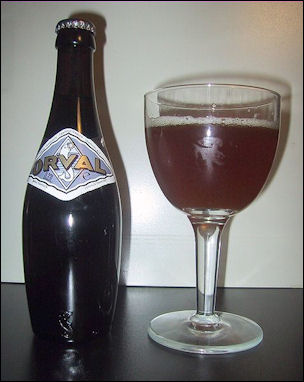 Belgium's 100 breweries produce 605 different beers (an incredible large number for a country of 10 million people) that fall into nine major categories. About 70 percent of these are lagers. The remaining 30 percent are 'specialty beers" that vary from light beers to stout-like ales.
Belgium's 100 breweries produce 605 different beers (an incredible large number for a country of 10 million people) that fall into nine major categories. About 70 percent of these are lagers. The remaining 30 percent are 'specialty beers" that vary from light beers to stout-like ales.
Among the hundreds of different brews you can try are ales brewed by Cistercian monks and a dark beer that ferments in the bottle. There is a pilsner made from cherries and an ale flavored with raspberry and peaches.
Choosing beer is often difficult. Many brewers make three or four different ales and the difference between them is often unclear. Belgians sometimes add wheat and corn with barley just as other brewers sometimes add oats, rye or rice. Dark beers can be as filling as a steak and potatoes meal.
Highly-regarded white beers include Bruges Tarwe White and Witbier. Among the novelty beers are cherry-flavored red Flanders ales of Ridenback aged in oak barrels and Delirium Tremen Beer.Lambrick ales are "funky, sour fruit-spiked ales” which ferment spontaneously with airborne yeasts that settle on open tanks rather that added yeasts. Well-liked Lambrick ales include Timmermans, Geuze and Kriek and Framboise, Lindeman's, Pecheresse and Cassis.
Monks and Trappist Beers and Ales
Belgium’s Trappist monasteries are famous for monks who have taken a vow of silence and produce beer with a high alcohol content and luscious flavor. Only six Trappist abbeys in the world still make beer, five in Belgium and one in the Netherlands. Cashing on the reputation of these abbeys are dozens of beers with monks or churches on their labels . Some commercial brewer have licensed abbey names and occasionally abbey recipes. In 1997, the six abbeys decided to put a hexagonal symbol on their labels as a mark of authenticity.

Trappist Brewery in
Abbey Notre-Dame de Saint-Remy The most famous Trappist beers are Chimay Red, Chimay White, Chimay Blue and Orval.
Chimay is the best known and widely distributed genuine Trappist Ale. It comes in three strengths, each with a different color to designated its different strengths. Chimay is darker and sweeter than Orval.
Among the Abbey-style ales ("sweat and creamy" and “deep and full-flavored") are St. Sebastiaan Dark, Leffe Blonde, Leffe Brune, Leffe Radieuse, Duvel and Affligem. Affliegm is a smooth abbey-style ale with bitter taste from the hops and hints of chocolate and honey. Duvel (from the Dutch word for "devil") is fermented in stages over eleven weeks like a Trappist beer. Its flavor is sweet and deep and has a lot of added sugar and light-roasted barley to give it a high alcohol content of 8.5 percent.
"What makes Trappist and abbey-style ales stand apart," Corby Kummer wrote in Atlantic Monthly, "is multiple fermentations with different strains of yeasts, at both low and high temperatures, and a final addition of yeast so that the beef will ferment again in the bottle... "This is precisely the method that champagne producers use, to add depth and new flavors. Also as with “méthode champenoise” wines, the beer's light carbonation results mainly from the fermentation in the bottle, which can go on for weeks, in expensively climate-controlled storerooms. Other beermakers simply inject beer with carbon dioxide as it is bottled." Another secret is sugar, which give the brews their unusual strength and high alcohol content. Some are called "double" or "triple" ales because of the high alcohol levels resulting from the additional sugar.
Orval Trappist Beers and Ales

Chimays Orval is perhaps the most esteemed of the Trappist beers. It is produced in an abbey by the same name in a valley in the Ardennes in southeastern Belgium. A popular tourist site, the abbey is home to 50 monks who use the money they earn from beer, cheese and bread to keep the abbey going. Any profit is donated to charity.
The taste of Orval has been described as strong, dry and deep and not bitter despite its high hops content. Big tea-bag-like sacks of hops are dipped into the cooled beer as it ferments to give it "spiciness rather than bitterness."
Orval goes through three separate fermentations (most American beers go through one) over ten weeks. Some beer drinkers insist ale is not ready when it is purchased. To get the best flavor they recommend wait a year before drinking to allow the brew to become "bottle-conditioned."
Czech Beer
Budweiser originally came from Czech Republic but don't hold that against it. The Czechs many wonderful beer in beer in the country is cheap, plentiful and sold almost everywhere. There are also scores of different brews to try.
By some measures in some years the Czechs consume more beer than any other people, even the Germans. A common pastime among Czech men is smoking and downing pints of beer while watching soccer or hockey on television. Many drink beer for breakfast and pubs can be quite crowded in the morning as blue collar workers fill up before work.
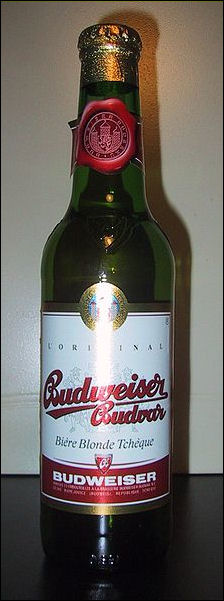
Czech BudweiserWhat are the ingredients that make Czech beer so great? "Pure water from deep wells and selected hops from Źatec," the director of the country's famed Pilsen's Brewery Museum told National Geographic . The famous "pilsner" is fermented in oak casks and constantly monitored. "No one 'manufactures' great beer," he added, "Brewing is a precision craft."
Hops fields in Czechoslovakia are a strange sight when you see them for the first time. Large tracts of land are covered with 20 foot-high poles and wire trellis covers with clinging hops vine. The yellowish fruit which is produced is what gives beer its flavor.
Cider
Often dismissed as a an old lady's drink, cider is very popular in some parts of Britain, particularly in Somerset, Devon, Cornwall and Wales, where some brews called scrumpy (unadulterated fermented apple juice) have an alcohol content of 8.4 percent.
Cider is made from apples and generally has less alcohol than beer. It was introduced to Britain from northern France after the Norman conquests. Popular British ciders include Dry Blackhorn (5.8 percent alcohol), Strongbow (5.3 percent alcohol), TNT (4.9 percent) and Woodpecker (4.2 percent).
Some pubs in Somerset, Devon and Cornwall serve 14 varieties of cider. There are sweet, dry, draft, keg and bottled cider, apple wine made with cider apples, oranges and lemons, designer ciders with name s like Diamond White and White Lightning.. Woodpecker is the most common commercial brand. Commercially bottled or keg cider is made with champagne yeast, then filtered, pasteurized, colored, sweetened, and carbonated. Susan Allen Toth wrote in the New York Times, even though it "always put me in a post-lunch drowse...I so much relish cider's fruity, mellow taste, spices with a hint of submerged bubbles.”
Cider is made like wine. Farm cider is usually made from apples picked up off the ground in October when they contain a natural yeast and is usually fermented for one year and sold the next year (the main cider season is late summer and fall). The quality and taste varies from orchard to orchard and year and year, depending on factors like weather, type of apple and other factors. During hot dry summer the sugar contents in apples is higher and thus the cider is stronger.
World’s Top Cider Exporting Countries
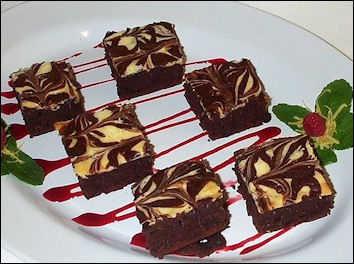
-Oatmeal stout browniesWorld’s Top Exporters of Cider and Cider-like Drinks (2020):; 1) Ireland: 116653 tonnes; 2) Mexico: 105271 tonnes; 3) Italy: 82034 tonnes; 4) Sweden: 74368 tonnes; 5) Germany: 73423 tonnes; 6) South Korea: 69667 tonnes; 7) Belgium: 69637 tonnes; 8) United Kingdom: 56633 tonnes; 9) Canada: 56163 tonnes; 10) South Africa: 48601 tonnes; 11) Netherlands: 43582 tonnes; 12) France: 41051 tonnes; 13) Austria: 37095 tonnes; 14) Lithuania: 33050 tonnes; 15) Hungary: 29751 tonnes; 16) Denmark: 28127 tonnes; 17) Estonia: 24334 tonnes; 18) Poland: 22135 tonnes; 19) Croatia: 18790 tonnes; 20) Slovakia: 18211 tonnes. [Source: FAOSTAT, Food and Agriculture Organization (U.N.), fao.org]
World’s Top Exporters (in value terms) of Cider and Cider-like Drinks (2020):; 1) Mexico: US$214173,000; 2) Italy: US$205959,000; 3) Canada: US$106835,000; 4) Sweden: US$86750,000; 5) Germany: US$81670,000; 6) United Kingdom: US$78900,000; 7) Ireland: US$67505,000; 8) South Africa: US$56600,000; 9) France: US$55319,000; 10) South Korea: US$55009,000; 11) Netherlands: US$53208,000; 12) Belgium: US$50585,000; 13) Lithuania: US$39410,000; 14) United States: US$36938,000; 15) Denmark: US$36631,000; 16) Austria: US$32103,000; 17) China: US$31305,000; 18) Spain: US$25818,000; 19) Australia: US$18987,000; 20) Estonia: US$18855,000
Image Sources: Wikimedia Common
Text Sources: National Geographic, New York Times, Washington Post, Los Angeles Times, Smithsonian magazine, Natural History magazine, Discover magazine, Times of London, The New Yorker, Time, Newsweek, Reuters, AP, AFP, Lonely Planet Guides, Compton’s Encyclopedia and various books and other publications.
Last updated March 2022
